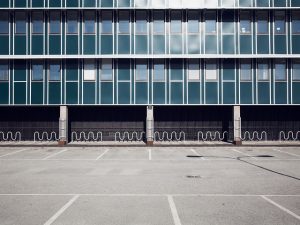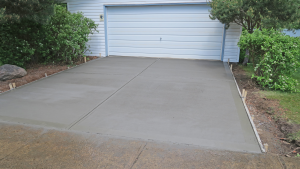Key Takeaway:
- Paving a commercial parking lot requires careful planning and material selection to balance initial costs,
- long-term maintenance, and functionality. Choosing the right contractor and design ensures durability, safety, and cost-effectiveness for years to come.
A commercial parking lot is often the first impression customers have of your business. Ensuring it is well-paved, durable, and efficiently designed can save you money while enhancing your property’s appeal. In this guide, we’ll explore cost-effective materials, innovative layouts, and essential tips to maximize your investment in paving commercial parking lots.
Cost-Effective Materials for Parking Lots
Selecting the right paving material is one of the most critical decisions when planning your commercial parking lot. Here are the pros and cons of everyday materials:
Asphalt
- Cost: Lower upfront cost compared to concrete.
- Durability: Excellent performance in various weather conditions, suitable for moderate to heavy traffic.
- Maintenance: Requires sealing and crack repairs periodically, but costs are manageable.
Concrete
- Cost: Higher initial investment.
- Durability: Long-lasting and resilient to heavy traffic and extreme weather.
- Maintenance: Minimal upkeep, but repairs can be more expensive than asphalt.
Gravel
- Cost: Most affordable initial cost.
- Durability: Best for low-traffic areas but prone to erosion and shifting.
- Maintenance: Frequent upkeep is needed to address erosion and maintain usability.
Effective Parking Lot Layouts
A well-planned layout improves traffic flow, safety, and space utilization while reducing long-term maintenance costs. Consider the following:
Maximize Space Utilization
Design angled parking spaces (e.g., 45° or 60°) to fit more vehicles without compromising traffic flow.
Minimize Traffic Congestion
Ensure clear pathways with wide aisles and avoid sharp turns to enhance safety and efficiency.
Plan for Future Expansion
Allocate areas for potential growth to accommodate increased traffic or business needs.
Ensure Accessibility
Design ADA-compliant spaces with proper signage and pathways to meet legal requirements and foster inclusivity.
Tips for Getting the Best Value When Paving Parking Lots
- Obtain Multiple Quotes
Request estimates from several contractors and compare costs, materials, and services to find the best deal.
- Choose the Right Material
Select materials based on traffic volume, climate, and budget. Asphalt often balances affordability and durability.
- Plan for Proper Drainage
Incorporate effective drainage systems to prevent water pooling and extend the pavement’s lifespan.
- Prioritize Quality Installation
Hire reputable contractors with experience in commercial paving to ensure a high-quality installation.
- Optimize Lighting
Install sufficient lighting for safety and improved visibility, reducing the risk of accidents and liability.
- Schedule Regular Maintenance
Routine inspections and timely repairs can prevent minor issues from escalating into costly problems.
- Choose the Right Timing
Pave during off-peak seasons to benefit from lower costs and faster project completion.
- Negotiate Contract Terms
Discuss warranties, payment options, and possible discounts to secure the best value.
- Plan for Sustainability
Consider environmentally friendly materials or recycling existing pavement to reduce costs and environmental impact.
- Communicate Your Needs Clearly
Work closely with your contractor to ensure they understand your goals, budget, and expectations.
Frequently Asked Questions (FAQs)
How long does it take to pave a commercial parking lot?
The timeline depends on the size of the lot and the material used. Asphalt paving typically takes 1-3 days for medium-sized lots, while concrete can take up to a week, including curing time.
What is the lifespan of a paved parking lot?
- Asphalt: 15-20 years with proper maintenance.
- Concrete: 20-30 years with minimal upkeep.
- Gravel: 5-10 years, depending on traffic and maintenance.
How can I prevent water damage to my parking lot?
Proper drainage systems, sloped surfaces, and routine maintenance like sealing and crack repairs help prevent water damage.
Is asphalt or concrete better for high-traffic areas?
Concrete is generally more durable and better suited for high-traffic areas, while asphalt is cost-effective and ideal for moderate traffic.
How do I ensure my parking lot complies with ADA standards?
Ensure designated accessible parking spaces with appropriate signage and pathways that meet ADA requirements. A professional contractor can assist in planning compliance.
Can I pave over an existing parking lot?
Yes, asphalt overlays are a cost-effective option if the existing pavement is in decent condition and the base is stable.
How much should I budget to pave a commercial parking lot?
Costs vary based on size, material, and location. On average:
- Asphalt: $2.50 to $4.50 per square foot.
- Concrete: $4 to $7 per square foot.
- Gravel: $1.25 to $2.50 per square foot.
What are common signs that my parking lot needs repairs?
Cracks, potholes, pooling water, and faded markings indicate the need for repairs or resurfacing.
How often should I seal coat my asphalt parking lot?
Sealcoating should be done every 2-3 years to protect against weather and wear.
Can paving increase my property’s value?
Yes, a well-paved parking lot enhances curb appeal, functionality, and safety, positively impacting property value.
Conclusion
Investing in a commercial parking lot is about more than just paving—it’s about ensuring long-term value, safety, and efficiency. By choosing the right materials, planning an effective layout, and working with skilled contractors, you can achieve a durable and attractive parking area that meets your business needs. For professional paving services in Jersey City, trust our team to deliver high-quality results tailored to your budget and vision.







